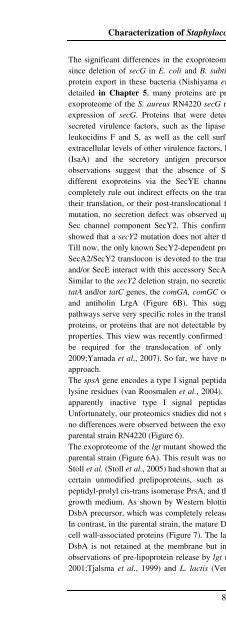The Staphylococcus aureus secretome - TI Pharma
The Staphylococcus aureus secretome - TI Pharma
The Staphylococcus aureus secretome - TI Pharma
Create successful ePaper yourself
Turn your PDF publications into a flip-book with our unique Google optimized e-Paper software.
Characterization of <strong>Staphylococcus</strong> <strong>aureus</strong> secretion mutants<br />
<strong>The</strong> significant differences in the exoproteome of the secG mutant were highly unexpected<br />
since deletion of secG in E. coli and B. subtilis does not seem to have a strong impact on<br />
protein export in these bacteria (Nishiyama et al., 1994;Van Wely et al., 1999). As further<br />
detailed in Chapter 5, many proteins are present at increased or decreased levels in the<br />
exoproteome of the S. <strong>aureus</strong> RN4220 secG mutant and this effect was reversed by ectopic<br />
expression of secG. Proteins that were detected in reduced amounts include well-known<br />
secreted virulence factors, such as the lipase Geh, the alpha and beta hemolysins and the<br />
leukocidins F and S, as well as the cell surface proteins SdrC and SdrD. Conversely, the<br />
extracellular levels of other virulence factors, like protein A, the immunodominant antigen A<br />
(IsaA) and the secretory antigen precursor SsaA were significantly increased. <strong>The</strong>se<br />
observations suggest that the absence of SecG changes the translocation efficiency of<br />
different exoproteins via the SecYE channel to different extents. However, we cannot<br />
completely rule out indirect effects on the transcription of the genes for certain exoproteins,<br />
their translation, or their post-translocational folding or degradation. In contrast to the secG<br />
mutation, no secretion defect was observed upon the deletion of the gene for the accessory<br />
Sec channel component SecY2. This confirmed the results obtained by Siboo et al., who<br />
showed that a secY2 mutation does not alter the S. <strong>aureus</strong> exoproteome (Siboo et al., 2008).<br />
Till now, the only known SecY2-dependent protein of S. <strong>aureus</strong> is SraP, and it seems as if the<br />
SecA2/SecY2 translocon is devoted to the translocation of this protein alone. Whether SecG<br />
and/or SecE interact with this accessory SecA2/SecY2 translocon remains to be determined.<br />
Similar to the secY2 deletion strain, no secretion defects were observed for strains lacking the<br />
tatA and/or tatC genes, the comGA, comGC or comC genes, or the genes for the holin CidA<br />
and antiholin LrgA (Figure 6B). This suggests that the Tat, Comand holing-antiholin<br />
pathways serve very specific roles in the translocation of particular non-abundantly expressed<br />
proteins, or proteins that are not detectable by 2-D PAGE due to their particular pI and size<br />
properties. This view was recently confirmed for the S. <strong>aureus</strong> Tat pathway, which seems to<br />
be required for the translocation of only one protein, namely FepB (Biswas et al.,<br />
2009;Yamada et al., 2007). So far, we have not been able to detect FepB by our 2-D PAGE<br />
approach.<br />
<strong>The</strong> spsA gene encodes a type I signal peptidase that seems to lack the active site serine and<br />
lysine residues (van Roosmalen et al., 2004). Interestingly, the occurrence of this type of an<br />
apparently inactive type I signal peptidase is wide-spread amongst the Firmicutes.<br />
Unfortunately, our proteomics studies did not shed light on the biological function of SpsA as<br />
no differences were observed between the exoproteomes of our spsA deletion mutant and the<br />
parental strain RN4220 (Figure 6).<br />
<strong>The</strong> exoproteome of the lgt mutant showed the most pronounced differences compared to the<br />
parental strain (Figure 6A). This result was not completely unexpected as previous studies of<br />
Stoll et al. (Stoll et al., 2005) had shown that an S. <strong>aureus</strong> lgt mutant released high amounts of<br />
certain unmodified prelipoproteins, such as the oligopeptide-binding protein OppA, the<br />
peptidyl-prolyl cis-trans isomerase PrsA, and the staphylococcal iron transporter SitC, into the<br />
growth medium. As shown by Western blotting, the same was true for the unmodified pre-<br />
DsbA precursor, which was completely released into the growth medium of lgt mutant cells.<br />
In contrast, in the parental strain, the mature DsbA fractionated with cells and non-covalently<br />
cell wall-associated proteins (Figure 7). <strong>The</strong> latter finding seems to suggest that some mature<br />
DsbA is not retained at the membrane but in the cell wall. <strong>The</strong>se findings confirm earlier<br />
observations of pre-lipoprotein release by lgt mutant strains of B. subtilis (Antelmann et al.,<br />
2001;Tjalsma et al., 1999) and L. lactis (Venema et al., 2003). <strong>The</strong> release of lipoprotein<br />
87













